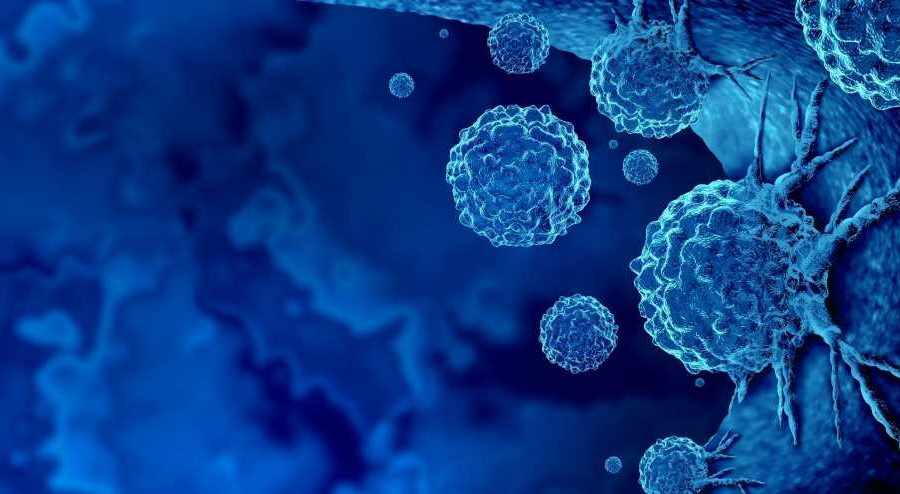New PCNA inhibitor AOH1996 shows selective cancer cell killings and tumor suppression potential
A recent study published in the Cell Chemical Biology Journal described a small molecule inhibitor of proliferating cell nuclear antigen (PCNA) that selectively kills cancer cells.
 Study: Small molecule targeting of transcription-replication conflict for selective chemotherapy. Image Credit: Lightspring/Shutterstock.com
Study: Small molecule targeting of transcription-replication conflict for selective chemotherapy. Image Credit: Lightspring/Shutterstock.com
Background
PCNA is a conserved multi-faceted protein in eukaryotes with a critical role in DNA replication and repair and has been historically used as a marker for tumor progression.
DNA replication stress is a key hallmark of cancer cells that have been exploited as a therapeutic strategy to induce further DNA damage leading to catastrophic consequences for cancer cells.
Thus, PCNA represents a major anti-cancer target, given its role in DNA replication/repair. Besides, discovering a distinct cancer-associated PCNA isoform (caPCNA) has opened new avenues for developing novel chemotherapeutics. Previously, the authors described a potential inhibitor (AOH1160) of caPCNA that lacked suitable metabolic properties.
The study and findings
In the present study, researchers identified and characterized the molecular features of AOH1996, an analog of AOH1160. They modeled the interactions between PCNA and potential ligands to design and synthesize around 70 analogs of AOH1160 by modifying the molecule's glycine linker, diphenyl ether, and a naphthyl group.
The Naphthyl group was replaced with mono- or bi-cyclic aromatic groups; the glycine linker was substituted with unnatural and natural amino acids. These modifications caused no improvements in potency. Thus, diphenyl ether was explored for its structure-activity relationship in several ways that led to the identification of two analogs, AOH1160-1LE and AOH1996.
Thermal denaturation analyses of these compounds indicated stabilizing interactions with PCNA. The researchers created cell lines with mutant PCNA, with L47V substitution, and evaluated their sensitivity to AOH1996. All mutant cells were less sensitive to inhibition by AOH1996 than wild-type cells, and homozygous mutants were the least sensitive.
Next, the team tested AOH1996 in normal cells and over 70 (cancer) cell lines. They found that AOH1996 selectively killed cancer cells, with a median concentration of about 300 nM for 50% growth inhibition.
AOH1996 was not significantly toxic to non-malignant cells, even up to 10 µM. It induced cell cycle changes (G2/M or S phase arrest) and apoptosis in cancer cells but not non-malignant cells.
AOH1996's half-life increased by approximately 27% relative to that of AOH1160 in oral pharmacokinetic studies in mice.
Next, its anti-cancer activity was evaluated in mice with xenograft tumors of small-cell lung cancer, breast cancer, or neuroblastoma. Drug treatment significantly decreased tumor burden without causing significant weight loss or death.
Further analyses showed that AOH1996 altered more than half the proteins associated with chromatin-bound PCNA, and these proteins were transcription components. However, only two proteins, subunits of RNA polymerase II (RNAPII), including its largest subunit (RPB1), harbored a known PCNA binding motif.
Next, the team exogenously expressed FLAG-tagged wildtype and mutant RPB1 proteins and performed immunoprecipitation, noting that AOH1996 increased chromatin-bound wildtype RPB1 as well as PCNA co-precipitation with wildtype RPB1. This suggested that AOH1996 increased transcription-replication conflict (TRC) and enhanced RPB1-PCNA interactions.
These effects were further amplified in the presence of a proteasome inhibitor (MG132), suggesting that AOH1996 can trigger RPB1 proteasomal degradation. Contrastingly, PCNA co-precipitation with mutant RPB1 was reduced in the presence of MG132 and AOH1966, suggesting weakened interactions.
Examination of exogenous RPB1 levels in whole cell extracts revealed that AOH1996 degraded wildtype RPB1 in a proteasome-dependent manner but not the mutant RPB1.
Further, AOH1996 caused the dissociation of PCNA from actively transcribed regions but not in low or non-transcribed heterochromatin regions. This suggested that AOH1996 triggered the collapse of replication forks only during active transcription.
Conclusions
In sum, the study reported two AOH1160-based inhibitor analogs, and the lead candidate, AOH1996, was more metabolically stable with drug-like characteristics. AOH1996 enhanced PCNA-RPB1 interactions, leading to the overall degradation of RPB1 and the collapse of replication forks in actively transcribed regions.
Specifically, these enhanced interactions prevent TRC resolution, leading to lethal double-strand breaks and the disruption of the transcription machinery by the degradation of RPB1.
CaPCNA disrupts the PCNA-TRC interface in cancer cells, allowing AOH1996 to exert selective and potent anti-cancer effects with a remarkable safety profile.
Overall, the study underscores the therapeutic potential of AOH1996 and its utility in characterizing TRC in cancer cells. Given its multi-functionality, further studies are required to understand the effects of AOH1996 on other aspects of PCNA.
-
Gu L, Li M, Li CM, et al. (2023) Small molecule targeting of transcription-replication conflict for selective chemotherapy. Cell Chemical Biology., doi: 10.1016/j.chembiol.2023.07.001. https://www.cell.com/cell-chemical-biology/fulltext/S2451-9456(23)00221-0#%20
Posted in: Drug Discovery & Pharmaceuticals | Cell Biology | Device / Technology News | Medical Science News | Medical Research News | Medical Condition News
Tags: Antigen, Apoptosis, Breast Cancer, Cancer, Cell, Cell Cycle, Chromatin, DNA, DNA Damage, DNA Replication, Eukaryotes, Glycine, Immunoprecipitation, Lung Cancer, Malignant, Molecule, Neuroblastoma, Polymerase, Proteasome Inhibitor, Protein, RNA, Stress, Transcription, Tumor, Weight Loss, Xenograft

Written by
Tarun Sai Lomte
Tarun is a writer based in Hyderabad, India. He has a Master’s degree in Biotechnology from the University of Hyderabad and is enthusiastic about scientific research. He enjoys reading research papers and literature reviews and is passionate about writing.
